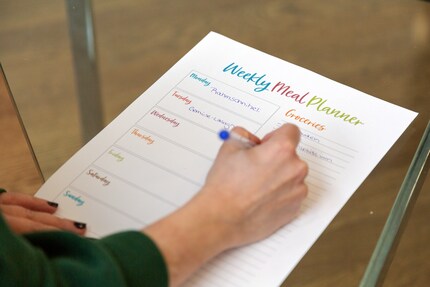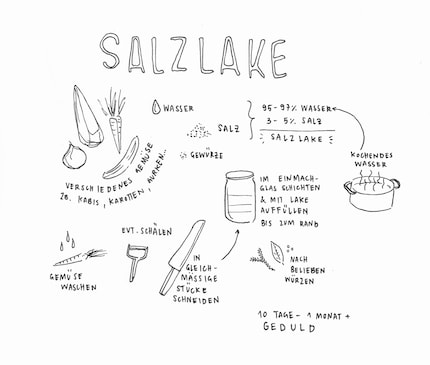
Guide
Sous vide: food from a bag
by Vanessa Kim

My heart bleeds every time, and yet I do it over and over again: throw food away. The good news is, everyone can save food. No superhero powers required.
They taste bitter. I turn up my nose and chuck the hazelnuts I fished out of a dark corner of my kitchen cupboard into my compost container. Unfortunately, that’s not an exception. At least not in my household, nor in most households in Switzerland. One third of our food is wasted. This happens in agriculture, processing, wholesale and retail, catering and, finally, with the end consumer. And that’s you and me. According to the WWF, 31 per cent of the food wasted in Switzerland is wasted by us. That equals an annual 330 kilos of food per head, 600 francs per household and a quarter of all greenhouse gases. Pretty shocking, right? So I got in touch with zero waste activist Carla Opetnik to get some tips on how to reduce these numbers.
Remove one shelf from your fridge or kitchen cabinet. If you’ve got less space, you’ll automatically buy less. This simple step prevents you from using the excess space to hoard half-used sauces, jars and packets of nuts you rarely use or forget about.
Put together a menu plan for the week on the weekends. Before you start, take a look at what’s in your kitchen cupboards and fridge. You might come across food that’s about to expire and can be incorporated in your menu plan. Once your plan’s in place, it will be your go-to document to base your shopping list on. More often than not, we simply buy whatever tickles our fancy. Armed with a list and a full belly, you can prevent this from happening.

You can also save a lot of «waste» when you’re preparing food. Do you really need to peel your vegetables? In most cases, the peel is not only edible but also high in fibre. Take broccoli stalks, for example. They can be eaten raw and taste a bit like kohlrabi. Vegetable leaves don’t necessarily need to go either. Radish leaves are a great alternative to chili. Whizz them up in a blender and drizzle in a bit of oil to make a paste. Store it in the refrigerator and use it to spice up meals. Carrot greens taste great in salads or can be turned into a pesto sauce. There’s also no need to chop off two centimetres at the end of carrots. Try to leave vegetables as they are, even if this doesn’t look very pretty. Use the stem of tomatoes and eat your next apple with its core. It’s all a question of habit.
Important: ensure that any unsalvageable green waste ends up in the compost. Either chuck it in your own compost and turn it into earth, or pop it in a green wheelie bin so that it can be used to make biogas or earth.
Our fruit and veg is grown to be bigger and bigger, because there’s a demand. There’s a size norm every fruit and vegetable needs to comply with. Larger or smaller specimens don’t make it to shops and end up back in the field they were grown in. I know this may sound really obvious, but just buy smaller versions. Unfortunately, we often believe bigger is better. The consequence of this attitude is only half eating food, such as apples, and leaving lots of flesh around the core (which, as we have learned, can be eaten, too).
If you live in a one-person household, many foods tend to be too large in terms of volume. So let’s say you’ve bought too many veggies. Just place whatever you’re not using in brine and weigh it down so nothing is sticking out. Check out Carla’s brine recipe below. This is definitely a great way to keep food fresh for longer. Another way of storing perishables is freezing it. Buy a cauliflower that’s way bigger than your recipe asks for? Just break it up into little florets and pop half of it in the freezer. This saves you eating cauliflower for several days in a row, and you’ll have some ready in no time the next time you fancy it. And your freezer is great for storing so much more than just vegetables, ice cream and ready-made pizzas. Cake, bread (pre-cut in slices if you’re not planning on using the entire loaf), soups and that Bolognese sauce you made too much of all freeze really well. Just make sure that the portions you freeze are the right size. If not, you’re back at square one.

It’s quite common to occasionally take cakes or sweets to work or school. But what about bread, pasta or the like? That’s quite uncommon. The culture of sharing is not deeply rooted in our society because food is a status symbol. Swim against the stream. If you have a communal kitchen or a break room at work, designate a shelf in the fridge or a certain table as a food sharing space. In other words, any foodstuff you place there is free to use. You could also create a WhatsApp group with the same purpose. Cook too much rice? Ask the group if anyone fancies eating rice salad the next day. Take the communal spirit to the next level by spontaneously inviting friends or neighbours for dinner or bringing them some food.
With the help of apps such as Too Good To Go you can save food surpluses from cafés and restaurants by purchasing them at a lower price. Or join a group such as the «Stop Foodwaste (Zurich)» chat on Telegram to share food with others. It’s also a great way of emptying your fridge before you go on holiday, for example. You’re bound to find someone who’ll be happy to take your food. All it takes is a bit of effort, because, unfortunately, chucking food is still the easiest option.
What’s your tip to reduce food waste? Thanks for sharing it in the comments field below. 🥕
As a massive Disney fan, I see the world through rose-tinted glasses. I worship series from the 90s and consider mermaids a religion. When I’m not dancing in glitter rain, I’m either hanging out at pyjama parties or sitting at my make-up table. P.S. I love you, bacon, garlic and onions.
Practical solutions for everyday problems with technology, household hacks and much more.
Show all